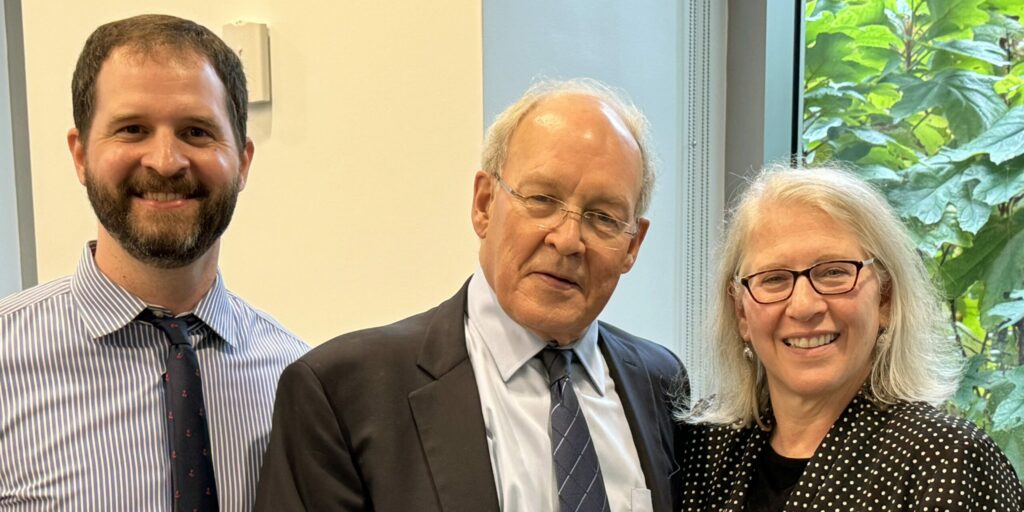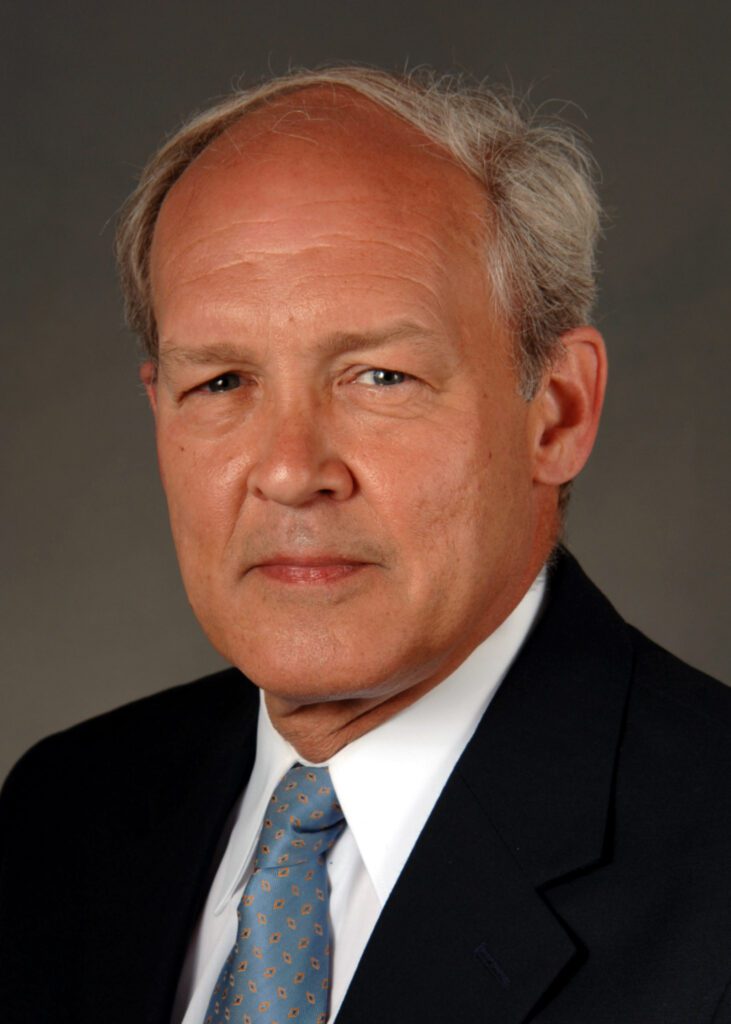
Every year since the inauguration of the AAI Public Policy Fellows Program (PPFP) in 2011, early-career immunologists with an interest in shaping science policy have been welcomed to Washington, DC, by Hugh Auchincloss, M.D. (AAI ’83, DFAAI). Before the visits to Capitol Hill to meet with their Congressional delegations, Dr. Auchincloss, then the principal deputy director of the National Institute of Allergy and Infectious Diseases (NIAID), would brief them on the realities of NIH and NIAID funding
Hugh Auchincloss has been a constant presence among the PPFP fellows as a mentor, offering wisdom from years of experience as an NIH administrator. In 2024, Auchincloss retired, ending an illustrious career in science and federal policy.
“It has been the privilege of a lifetime to work for Tony Fauci. Can you imagine? I mean, I’ve got no claim to fame about what I’ve been doing for the past 17 years. I’m not the greatest scientist. But somehow I ended up in a position in which I’ve watched one of the great Americans do extraordinary things.”
Finding Immunology
From a young age, Auchincloss wanted to follow in his father’s footsteps and become a surgeon. At Yale, he initially declared as pre-med, but “got increasingly caught up in history, economics, and government.” He only completed his pre-med requirements by enrolling in a special program that awarded a bachelor’s degree in political science and a master’s in economics, which proved valuable in his later career.
His next step was Harvard Medical School, after which he found himself at NIAID conducting immunology research through an NIH fellowship. “At the time, I didn’t even know what an inbred strain of mice was,” joked Auchincloss, but he says he “thoroughly enjoyed” laboratory research. In 1981, Auchincloss’s very first paper was published in The Journal of Immunology.
Auchincloss’ career eventually took him back to Boston as a surgeon, where he served as Director of Pancreas Transplantation at Mass General, and Director of Kidney Transplantation at Brigham and Women’s.
Hugh Auchincloss at NIAID
In 2005, after 17 years as a transplant surgeon and researcher, Auchincloss got a call from Richard Hodes, M.D. (AAI ’75, DFAAI), asking him to interview for the position of Scientific Director of the Intramural Program at NIAID. At that interview, however, members of the search committee recommended that he should apply for the position of Deputy Director instead. In January 2006, Anthony Fauci, M.D. (AAI ’73, DFAAI), called Auchincloss and offered him the deputy job, beginning a long and exciting collaboration.
Auchincloss “served as a funnel back and forth between Fauci and the rest of NIAID” during successive outbreak responses for chikungunya, ebola, zika, bird flu, and COVID-19. “I couldn’t have been in a more exciting situation, with one thing after another happening,” said Auchincloss.
“It could be anthrax and he’d be on antibiotics for a long time, or it could be a neurotoxin and he’d be dead within minutes or hours.”
The COVID-19 Pandemic

As one of just a handful of NIAID employees to work from the office every day throughout the COVID-19 pandemic, Auchincloss experienced the surreal and sometime frightening reality of life in Fauci’s inner circle. Each morning started with bomb-sniffing dogs checking out the work site. One day Fauci opened a piece of mail and saw white powder fall out on his desk. Auchincloss recalls that Fauci summed up the options. “It could be anthrax and he’d be on antibiotics for a long time, or it could be a neurotoxin and he’d be dead within minutes or hours.” Fortunately, it was the third possibility: a hoax. “All incoming mail was opened by the security team after that.”
Auchincloss and other administrators also screened all Fauci’s email, sending the potentially dangerous ones to the security team. He recalls that the head of security was particularly concerned about one series of violent threats that had been sent through numerous proxies and encrypted servers to hide the trail. Investigators traced the threats back to a rental cabin in Snowshoe, West Virginia, and the culprit was eventually sentenced to 37 months in federal prison.
Auchincloss counts the institute’s ongoing AIDS research among their major accomplishments. “We may never have a vaccine,” he says, “but the treatment options we have now have completely transformed the approach to the disease.” Auchincloss specifically cites the President’s Emergency Plan for AIDS Relief (PEPFAR) as a crucial component of this fight. A product of Fauci’s “vision and drive,” PEPFAR has saved over 25 million lives worldwide, mostly in Africa, through prevention, treatment, and strengthening of local health systems.
“PPFP and AAI help the fellows understand how to advocate to Congress to set scientific priorities.”
Public Policy Fellows Program
In 2003, Auchincloss joined the AAI Committee on Public Affairs and chaired the committee 2004–05, just before his move into federal science administration. As chair, Auchincloss pushed Congress to increase NIH funding, but also to address delays in the visa process for foreign students. “International collaboration among—and exchange between—scientists is crucial to the advancement of science,” he wrote to members of Congress. “Problems in the visa process can have a deleterious impact on this collaborative research by delaying or restricting the employment of foreign scientists.”
When AAI began the Public Policy Fellowship Program in 2011, Auchincloss welcomed the ten young scientists to Washington, D.C., at a working dinner. The drive for science advocacy stuck with many of them: fellows who visited their congressional representatives that first year have gone on to serve on the Committee for Public Affairs and even work in the STate Department and on White House councils.
“PPFP and AAI help the Fellows understand how to advocate to Congress to set scientific priorities,” says Auchincloss, “and help them understand what the function of a program officer is.” To him, the “most under-appreciated job” is a program officer at NIAID, or at NIH in general. “They have to know the science and the scientists. They have to be generalists who also understand many specialties. And they have a tremendous impact on the course of research.” The first piece of advice that Auchincloss would give to any young immunologist is to get to know their program officer at NIH.
Passing The Torch
When Fauci retired in 2022, Auchincloss was made Acting Director of NIAID. He describes the 11 months in that position as “no real change” in his role. When Jeanne Marazzo came in as Director, he stayed on as her deputy, describing her as “tremendous fun, a delightful person,” who has “many of the same values I’d become accustomed to with Fauci.”
In an interview with an NIH oral historian, Auchincloss described his tenure at NIAID with characteristic humility: “It has been the privilege of a lifetime to work for Tony Fauci. Can you imagine? I mean, I’ve got no claim to fame about what I’ve been doing for the past 17 years. I’m not the greatest scientist. But somehow I ended up in a position in which I’ve watched one of the great Americans do extraordinary things.”




